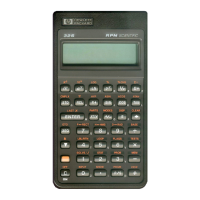Given any four of these variables, the
SOLVE
instruction (line L04)
finds
the
solution
for
the
fifth
one:
L01
LBL
L
L02
STO
i
L03
FN=
T
L04
SOLVE(i)
L05
VIEW(i)
L06
GTO(i)
Stores
an
index
value
that
indicates
which
variable
had
been specified as the unknown.
Selects the function defined in program
T.
Solves
for
the
indicated
unknown
variable
in program T.
Displays the resulting solution.
Returns to the initializing subroutine to pre
pare for another calculation.
This
SOLVE
operation works fine without the user supplying initial
guesses.
Limitations.
The
SOLVE
instruction
cannot
call
a
routine
that
con
tains another
SOLVE
instruction;
that
is, it cannot be used recursively
(S0LVE<S0LVE) error).
Nor
can SOLVEcall a routine
that
contains a
FN= label instruction (SOLVE ACTIVE error). SOLVE
cannot
call a
routine that contains an
/FN
instruction (SOLVECfFN) error), just as
/FN
cannot call a routine that contains a
SOLVE
instruction
(/<SOLVE)
error).
The
SOLVE
variable
instruction in a program uses one of the seven
pending subroutine returns in the calculator. (Refer to "Nested Sub
routines* in chapter 6.)
For
More
Information
This chapter gives you instructions for solving for unknowns or roots
over a wide range of applications. Appendix C contains more detailed
information about
how
the algorithm for
SOLVE
works, how to inter
pret results, what happens when no solution is found, and conditions
that
can
cause
incorrect
results.
7:
Solving
for
an
Unknown
Variable
in
an
Equation
125

